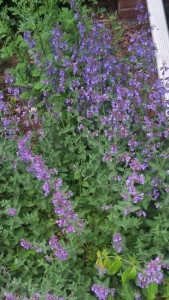
Walker’s Low catmint
Catmint (Nepeta × faassenii) is most often thought of as an ornamental perennial rather than as an herb. Catmint has earned the Royal Horticulture Society’s Award of Garden Merit. It is closely related to catnip (N. cataria) and even contains the same chemical, nepetalactone, which cats find so attractive. The nepetalactone is in lower concentrations in catmint but cats will still be drawn to the plants and roll around on them so it is usually a good idea to cover young plants with a wire dome to protect them until they are well established.
Catmint is not a naturally occurring plant. It is a hybrid resulting from the cross of N. racemosa, commonly called dwarf catmint or raceme catnip, with N. nepetella, commonly called lesser catmint. There are numerous cultivars, the most popular being Walker’s Low which contrary to its name, is not low-growing. Instead it can reach a height of 2 ½ to 3 feet. So don’t be fooled and plant it in the front of your garden as I did! Other cultivars range in height from 10 inches to 4 feet.
Catmint is a herbaceous perennial hardy in zones 3 through 8. It should be grown in full sun, although it will tolerate partial shade, and well-drained soil. Once established, it is drought tolerant. It does not require fertilization. In fact, it will become tall and leggy if fertilized. A layer of compost each spring is all the nutrients that catmint needs. It is disease and deer resistant. The fragrant grayish foliage is an insect repellent.
The newer cultivars produce sterile seed, so propagation is usually done by division in the spring. Like other perennials, you should divide your plants every 3 to 4 years. Plant your divisions at least 12 inches apart. Overcrowding could result in powdery mildew from poor air circulation. Keep your divisions well-watered until they have become established.
Catmint flowers on long stems with lavender, pink or white flowers. Bloomtime is spring to early summer, but if you shear off the spent flowers, your plants could bloom again later in the summer. The second flush of blooms won’t be as impressive as the first spring blooms. Some cultivars bloom continuously throughout the summer into fall. The flowers attract bees, butterflies and hummingbirds.
In the fall, cut the plants to the ground to prevent insects and disease from overwintering in the dead foliage.

